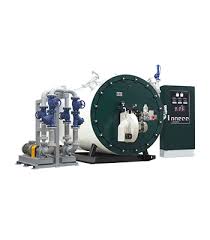
Dek . 11, 2024 19:39 Back to list
low pressure steam boiler
Understanding Low Pressure Steam Boilers
Low pressure steam boilers are essential components in various industrial processes and heating applications. Unlike high pressure boilers, which operate at pressures exceeding 15 psi, low pressure steam boilers function at pressures below this threshold, typically between 0 and 15 psi. This defining characteristic allows them to be used in a myriad of settings where safety and efficiency are paramount.
How Low Pressure Steam Boilers Work
The fundamental working principle of low pressure steam boilers revolves around the conversion of water into steam through heating. These boilers typically consist of a pressure vessel equipped with fuel and air delivery systems, heat exchangers, and safety mechanisms.
When water is heated, it undergoes a phase transition, transforming into steam. In low pressure steam boilers, this process is carefully monitored to ensure that the steam remains at low pressure, which is safer for operating personnel and equipment. Common fuels used in these boilers include natural gas, propane, oil, or even biomass, which contributes to their versatility across various industries.
Applications of Low Pressure Steam Boilers
The broad range of applications for low pressure steam boilers makes them crucial in both commercial and industrial domains. One significant area is in heating. They are often employed in building heating systems, providing consistent and controllable warmth to indoor environments. Moreover, they are widely used in laundries, paper mills, and food processing facilities, where steam is necessary for sanitation, cooking, or other processing tasks.
Furthermore, low pressure steam boilers are well-suited for use in district heating systems, where steam is distributed through a network of pipes to heat multiple buildings
. This not only increases efficiency but also reduces overall emissions by centralizing energy production.Benefits of Low Pressure Steam Boilers
low pressure steam boiler

Low pressure steam boilers offer numerous advantages. One of the most significant benefits is their safety. Operating at lower pressures minimizes the risk of dangerous steam explosions, making them a safer choice for facilities that may not have extensive safety measures in place.
Additionally, low pressure systems are often easier to operate and maintain. They typically require less rigorous training for personnel compared to high pressure systems, reducing the operational overhead for companies. The simplicity of operation can lead to fewer maintenance issues and decreased downtimes, which translates to increased productivity.
Another crucial benefit is energy efficiency. Although low pressure steam systems may not achieve the same efficiency ratios as high pressure systems, they can still deliver optimal performance with the right technologies in place. Modern low pressure steam boilers are designed to maximize heat transfer and minimize fuel consumption.
Environmental Considerations
In recent years, there has been a growing emphasis on sustainability and decreasing the carbon footprint associated with industrial processes. Many modern low pressure steam boilers are designed with eco-friendly standards in mind. This includes options for renewable fuels like biomass and the integration of advanced combustion technologies that minimize emissions.
Additionally, the use of condensing economizers can increase the overall efficiency of these systems by capturing waste heat from exhaust gases, thus enabling facilities to utilize more of the energy produced from their fuel sources.
Future Trends
As industries continue to evolve, the demand for low pressure steam boilers is expected to grow. Mechanical advancements and the push towards greener energy solutions will likely lead to innovations in design and efficiency. Manufacturers are increasingly focusing on smart technologies, enabling real-time monitoring and control of boiler operations, which can further enhance safety and efficiency.
In conclusion, low pressure steam boilers are integral to many industrial processes and heating applications. Their safety, ease of operation, and expansive use cases make them an ideal choice for various facilities. As technology advances and environmental priorities shift, the future of low pressure steam boilers looks promising, combining efficiency with sustainability to meet the needs of modern industries.
-
Commercial Steam Boilers for Sale - AI Optimized Efficiency
NewsAug.02,2025
-
Efficient Biomass Fired Hot Water Boiler | AI Heating Solution
NewsAug.01,2025
-
High-Efficiency Gas Thermal Oil Boilers | HPT Models
NewsJul.31,2025
-
Oil Fired Hot Water Boilers Sale - High Efficiency & Affordable
NewsJul.31,2025
-
High-Efficiency Commercial Oil Fired Steam Boiler for Industry
NewsJul.30,2025
-
High-Efficiency Biomass Fired Thermal Oil Boiler Solutions
NewsJul.30,2025
Related PRODUCTS






















